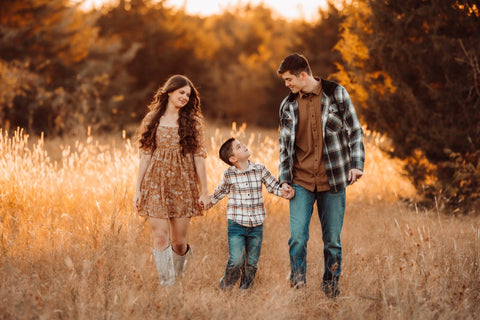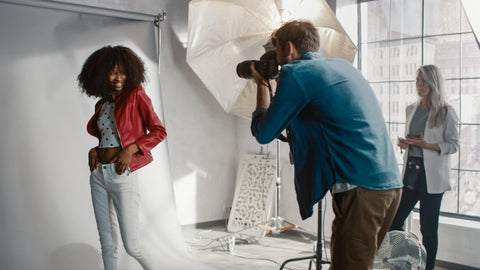- Lightroom Presets
- Mobile Presets
-
Photoshop
-
Learn
-
Support
-
Install
- Best Sellers
- Blog
By Ana Mireles on | No Comments

When taking photos of individuals wearing glasses, an issue often encountered is the presence of glare. Sometimes this glare can be incredibly intense, obscuring the underlying details entirely, and can be really hard to fix later on.
Fixing this type of glare in post-processing is not easy. This is why tackling the problem when initially taking photos is generally more advantageous. Invest a few moments in locating the optimal angle rather than expending hours attempting to rectify it at a later stage.
In this tutorial, we will cover both:
Let's begin by examining the root cause of glare. Glare primarily arises when light reflects off surfaces such as glasses, creating a bounce-back effect onto the camera lens. It's essential to understand this concept because it will help you to preemptively counteract the occurrence of glare.
As light emanates from a source and encounters glasses (or any reflective surface), it follows a straight path, making contact at a specific angle termed the "angle of incidence." This angle governs the orientation at which light rebounds off the glasses, referred to as the "angle of reflection."
The angle at which light strikes is mirrored in its reflection angle. Therefore, if the camera aligns with the reflection angle, glare will appear in your photos.
Consequently, IF YOU NOTICE GLARE WHEN TAKING PHOTOS, IT IS ESSENTIAL TO MODIFY THE ANGLE OF REFLECTION TO PREVENT IT.

To prevent or diminish glare when taking photos, various modifications can be implemented to alter the shooting angle. This includes options like repositioning the subject or your camera, adjusting the light source, and even experimenting with the angle of the glasses.
Nonetheless, it's vital to remember that each alteration will yield distinct effects on your photograph.
You will need to find the right balance and make a choice.
If you were not able to consider these factors beforehand or still want to keep the image despite the glare, there are some ways to remove or reduce its impact in Lightroom.
Traditionally, Lightroom isn’t the typical software you would use to reduce glare in photos. However, the latest versions of Lightroom have tools that make this task easier. I’m using Lightroom Classic 12.1. If you’re using a previous version, please consider updating your software to follow along.
Below is a before and after example image, showing the glasses with glare and after editing to remove the glare in Lightroom:

In the following steps, I'll demonstrate two straightforward techniques within Lightroom to effectively eliminate glare from glasses:
Using the Masking tool is the easiest approach to removing glare from glasses in Lightroom, although its applicability may vary across images.
This technique involves fine-tuning the color and brightness of the glare, resulting in a more harmonious integration with the surrounding elements, making the adjustments less conspicuous.
To employ this technique effectively, the glare shouldn't be too strong. Following this guideline will ensure that the underlying eye details remain perceptible beneath the glare.
Let's delve into the process:

To remove glare using the Masking tool, first, you need to select and create a mask. That way, all the adjustments you make will be applied only to the glare-affected area without affecting the rest of the image.
To create a mask, activate the Mask tool by clicking on its icon, which can be found on the far right beneath the Histogram. The icon looks like a circle drawn with a dotted line. Alternatively, you can press the keyboard shortcut Shift+W on your keyboard.
Once you activate the Mask tool, its panel will display the various options available to create a new mask.
Locate the Brush tool within this panel and click it. You can also press K on your keyboard, a handy Lightroom shortcut.
Once you do this, the Mask panel will pop up just to the left, where you will see "New Mask" and "New Brush."
Here you can enable a color overlay to monitor the progress of your mask. I like to use an overlay and find it helpful, but you can also turn it off if you find it disconcerting; its activation or deactivation won't affect the mask itself.

Meanwhile, on the right side, the Mask tool panel transitions into the Brush tool panel, where you can adjust the brush's size, feather, flow and density.
You also have the option to activate Auto Mask here. This feature can be pretty handy in specific situations. In my case, I didn't need it for this example. However, experimenting with Auto Mask can be beneficial if you are having difficulty creating a mask.
Now that you're prepared, you can zoom in and apply the mask.

If you accidentally cover an area you didn't intend to, use the Subtract button and paint over the unwanted portion to remove it from the mask.
Once your mask is set, it’s time to remove the glare by lowering the brightness and removing any color casts.
To match the brightness with the surrounding area of the image, I decreased the Highlights and the Exposure using the sliders. Then, I removed the color casts by initially modifying the Tint and Temperature sliders and tweaking the Hue and Saturation sliders. This process involved a bit of back and forth from one slider to the other until I was satisfied with the outcome.

The exact combination of values will differ for every photo, so don’t try to copy the same settings I used.
Instead, experiment with the sliders to see how they affect your image. And zoom out every once in a while to evaluate the overall progress and effect of your adjustments.
Sometimes you won't be able to remove the glare entirely. However, you will be able to make it less visible.
Once satisfied with the outcome, you can export your glare-free image for saving or sharing beyond Lightroom.
To proceed, access the File menu and select Export. This action will open a dialog box, allowing you to configure the export settings for your file.
Within this dialog, you can specify the destination folder, size, resolution, and other relevant parameters. You also have the option to retain or remove metadata from the image and, if desired, apply a watermark.
Once all the necessary adjustments are in place, click the Export button to finalize the process.
Another way to remove glare from glasses in Lightroom is by using the Healing tool.
Below is a before and after example image, showing the glasses with glare and after using the healing tool in Lightroom to remove the glare:

Here is how it works:
To remove glare using this technique, start by selecting the Healing tool located within the toolbar just beneath the Histogram. To activate the Healing tool, click the Band-Aid icon in the toolbar located above the Basic Panel.
Once you click on it, the Healing tool properties panel opens directly below. The first menu allows you to select one of three modes: Content-Aware Remove, Heal, and Clone. All of these modes can be effective for removing glare.
In this example, I'm using the Heal mode. Using the sliders, I adjusted the brush size, opacity, and feather settings, which may vary depending on the image. It's worth noting that when dealing with varying glare intensities within the same image, you might need to adjust these settings multiple times. Employing a smaller brush size near the edges is also recommended.
I recommend zooming in to work more precisely, but not too close. Unless you're utilizing the Content-Aware Remove mode, maintaining visibility of the surrounding area is essential for selecting a sample.
Now, start painting over the glare you want to remove. If you are using Heal or Clone, you will see a line indicating the painted area and a connecting line to the sampling area.

If you are not satisfied with the automatic result, simply click and drag the sample area to a different location on the image. As you relocate the sample, the healing area will reflect changes in real time. Continue fine-tuning until you pinpoint the most suitable sample area. This process can be repeated as necessary.
Lightroom will create a little "pin" (a bandaid icon in this case) for each place you use the healing tool. If you have applied multiple brush strokes, each stroke will have a corresponding band-aid icon.

If you have a lot of brush strokes, things can get cluttered very quickly and prevent you from seeing what you are doing. The best way to handle this is to tap the "H" key. All the icons will disappear when you do this and reappear when you tap the "H" key again.
Alternatively, you can switch between the before and after views by clicking and holding down the "eye" icon located at the bottom left of the Healing Tool panel.

After you've completed your editing, it's essential to export the image to make it accessible outside of the program. Otherwise, it will remain confined to Lightroom.
To initiate the export process, navigate to the File menu and select Export. Alternatively, you can use the Lightroom keyboard shortcut Shift+CTRL+E (PC) or Shift+CMD+E (Mac). This will open a window where you can configure the export settings for your image.
Additionally, you can utilize "Export with Previous" if you wish to employ the same settings as your last export. And if you have saved previous export settings, you can use "Export with Preset" and choose the export preset you want.

As mentioned previously, I used Lightroom Classic 12.1 (Lightroom 2023) for this tutorial. The Content-Aware Remove tool was introduced in this version, which debuted in October 2022.
Since that was the only brand new tool mentioned in this tutorial, you can still utilize both methods to eliminate glare, EVEN IF YOU ARE UTILIZING AN EARLIER VERSION OF LIGHTROOM. Of course, the tools in previous versions may have a slightly different appearance.
I hope you found these techniques helpful. Please let us know if you have any additional tips for removing glare in Lightroom. We love reading about your experiences.
Do have any questions or ideas about Removing Glare in Lightroom? Leave us a comment below - We would LOVE to hear from you! And PLEASE SHARE this tutorial using the social sharing buttons - (we really appreciate it)!




Ana Mireles is a Mexican photographer and researcher with a passion for writing and teaching. She’s collaborated in artistic and cultural projects in Mexico, Italy, and the Netherlands.

Comments